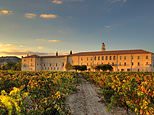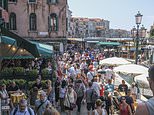
Halfway through our epic, multi-course lunch with all the Michelin trimmings – miniature stools for handbags; anchovy butter; tiny rolls of beetroot sitting atop seaweed, barely visible through the billowing dry ice – I’m asked a question.
‘Don’t you feel a little uncomfortable, enjoying all this in the refectory where monks ate bread and soup in silence before retiring, not to the swimming pool for a siesta, but to their cells for further prayer and circumspection?’
‘Not a bit,’ I tell my wife, Joanna. Admittedly, it’s a tetchy riposte. But I make my case that the monks would be delighted that their 12th Century monastery has been restored with such extraordinary reverence and transformed into a celestial retreat, amid rows of immaculate vines – remarkably similar to those that sustained them for centuries.
‘Only asking,’ says Joanna, who, a few hours later, undergoes a conversion and suggests that we should return to Abadia Retuerta, a couple of hours drive north of Madrid, every year for as long as the good Lord is prepared to put up with us.
Consider it done, although we will need to save some pennies. Rooms here are not cheap, but what you get in return goes way beyond food and lodgings. Suffice it to say that on day two I come up with a grand pronouncement that understandably doesn’t cut much ice with Joanna. ‘I feel like a better person,’ I tell her.
Mark Palmer checks into Abadia Retuerta, a former monastery that lies a couple of hours’ drive north of Madrid
Trite but true. The monks may have long gone – driven out in 1835 when the Spanish prime minister had a Henry VIII moment and closed down all monastic communities – but in a way they are also still here.
You sense their presence in the vaulted cloisters and Chapter House; through the wide corridors that stretch the entire length of the building; down near the canal and River Duarte where fruits, vegetables and herbs make the short journey from raised beds to the kitchens; and in the massive Baroque/Romanesque church itself where little imagination is required to see the priests processing in, wearing their white and cream habits. The staff, many of them local, wear the same colours as they glide about.
Out on the main terrace, swifts and swallows flit from one crevice to another, while at the top of the bell tower the hotel’s semi-permanent residents flap their wings from time to time as they protect their brood. These are the storks, a male and female who spend their winters in Africa before returning here every spring to breed, their 3ft-high nest built on a man-made platform just below a small cross. Pride of place.
Pictured is the walled pool area at Abadia Retuerta. ‘Making a splash here would be out of keeping with the serene mood,’ says Mark
Central to Abadia is the wine, Mark reveals. Above is the retreat’s special blend
There were once 600 French Premonstratensian Order monasteries in Europe, but Abadia Retuerta is one of only two that have survived. It is owned by Novartis, the pharmaceutical company based in Basel, Switzerland, which acquired the whole estate in 2008 and set about a project that consistently has won plaudits from various heritage bodies.
Novartis has a renowned art collection, some of which adorns the walls of the hotel – mainly the work of 17th Century painters such as Guardi, along with tapestries from the Louis XIV period and creations by, among others, Spanish sculptor Eduardo Chillida.
Central to Abadia is the wine. Indeed, if you’re not interested in or don’t want to learn about the intricacies and challenges of producing wines – mainly from the tempranillo grape – in an area of northern Spain which often endures damaging frosts well into early spring, then perhaps you might be better heading for the Costas instead.
‘It is good that the grapes should suffer – but not too much,’ says Francisco Sanchez de Puerta Galvan, who, with his great name and great font of knowledge, has worked at Abadia Retuerta for 12 years.
We join one of his estate tours, during which he tells us that more than 5,000 pine trees were planted in the 1990s to protect the vines. He also explains how the estate was one of the first to use windmills to blow the cold air away from the budding grapes. We finish with a tasting at the factory and then lunch outside the visitors’ centre.
I’ve always felt short-changed by tapas, but not this time. And seldom does a whole Michelin performance get me calling for an encore, but that lunch in the refectory, with an original Last Supper painting above our table – discovered during the monastery’s restoration – was stupendous.
This is not a tourist area of Spain. The nearest coast is a good 150 miles away, but the region is rich with interest.
Half an hour west of Abadia Retuerta is Valladolid, once the capital of the Spanish empire, where Philip II was born – the man who might have reshaped Britain if Elizabeth I had accepted his proposal of marriage in 1559.
In the other direction is Penafiel, famous for its 10th Century castle that stands imperiously on a hill above the sleepy town.
‘Rooms here are not cheap, but what you get in return goes way beyond food and lodgings,’ says Mark
TRAVEL FACTS
B&B doubles at Abadia Retuerta from £570, with a tour of the estate at £50 (abadia-retuerta.com). The hotel is a two-hour drive from Madrid Airport or an hour by train to Valladolid, followed by a 30-minute taxi ride. British Airways flies direct to Madrid up to five times daily, with return fares from £80.
But it’s not half as soporific as the walled pool area back at the Abadia Retuerta – reached through tall, metal gates – where guests seem to whisper. Making a splash here would be out of keeping with the serene mood.
Our room, with warm wood, hand-crafted furniture, French windows and a Juliet balcony, has a similar vibe.
There is little signage anywhere, no clutter, and the spa is hidden underground. Opt for a treatment and out comes the wine again.
You are invited to choose from oils containing sauvignon blanc, syrah or the winery’s Seleccion Especial (special selection) blend. A bottle of this wine sells for about £30 if you ever come across it in the UK. It’s nectar.
The Premonstratensian Order was founded by Norbert of Xanten in the early 12th Century, who was canonized by Pope Gregory XIII in 1582, his statue standing above the Piazza colonnade in Rome’s St Peter’s Square. Norbert was a strict disciplinarian (three of his followers died from the austere lifestyle) and was credited with a number of miracles.
What’s going on in his monastery now might not be miraculous – but it’s certainly divine.
SIX OF THE BEST HOTEL CONVERSIONS IN EUROPE
By Margherita della Gherardesca
Monastero Santa Rosa, Amalfi Coast, Italy
Dominican nuns at this former 17th Century convent once produced cream-filled pastries and medical remedies from the herbs and flowers grown in the gardens. With its motto, ‘At each window, the sun, from each window, the sea’, the hotel now offers unbridled luxury and one of the most dramatic infinity pools in Europe. B&B doubles from £770 (monasterosantarosa.com).
Enjoy ‘unbridled luxury’ at Monastero Santa Rosa on Italy’s Amalfi Coast
Steigenberger Inselhotel, Lake Constance, Germany
The inventors of the Zeppelin airship converted this 13th Century monastery into a hotel in the 19th Century, with most of the 100 rooms offering views of the lake. Inside, there are murals depicting the history of the monks and the town of Constance. B&B doubles from £210 (hrewards.com).
Katikies Garden, Santorini, Greece
Located in Santorini’s historic capital, Katikies Garden is a contemporary reworking of an 11th Century Catholic monastery. It has 40 rooms and a renowned restaurant, Selene, with Michelin-starred chef Ettore Botrini at the helm. B&B doubles from £400 (katikies.com).
Abbaye de la Bussiere, Cote-d’Or, France
Ancient frescoes were discovered during the conversion of this 12th Century Cistercian abbey, which sits within 17 acres of land next to the Burgundy canal. With just 20 rooms, the hotel provides a tranquil location for wine lovers. B&B doubles from £240 (abbayedelabussiere.fr).
Convento Espinheiro, Evora, Portugal
In the 15th Century, after tales of an apparition of the Virgin Mary surfaced, this chapel was built. Soon it developed into a monastery for the Order of St Jerome, visited by nobles and kings of Portugal. The hotel of 90 rooms sits ten minutes from the town of Evora, with its Roman temple and Chapel of Bones. B&B doubles from £190 (conventodoespinheiro.com).
San Clemente Palace, Venice, Italy
This 12th Century chapel was originally a hospice for pilgrims and soldiers headed to the Holy Land. It occupies its own small island next to Venice and is located a five-minute boat trip away from St Mark’s Square. B&B doubles from £420 (kempinski.com).
Source link
CHECK OUT: Top Travel Destinations
READ MORE: Travel News



